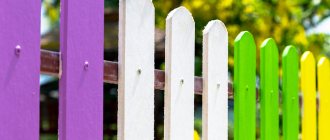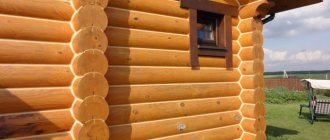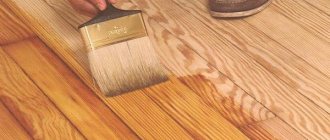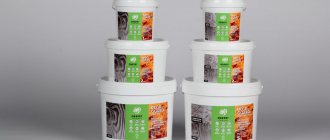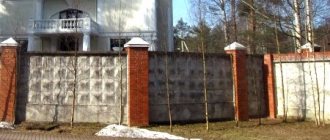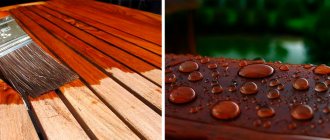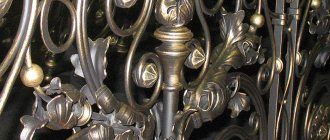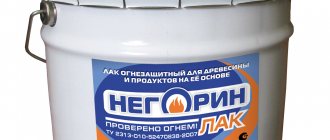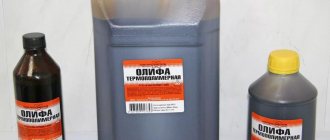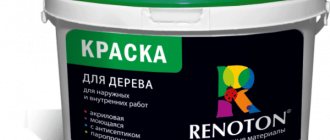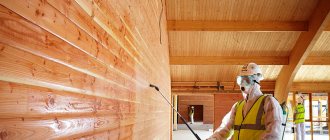When using wood as the basis for a future street fencing, it is important to provide for both preliminary processing of raw materials before fastening, and final processing, after installation of all elements.
At the finishing stage, the easiest way is to paint a wooden fence. This will be appropriate for any design, and the variety of colors allows you to please demanding customers. For those who do not want to hide the wood structure, there are antiseptics, varnishes and impregnations.
Users often search for:
- Construction of a decorative wooden fence
- Wooden fence made of unedged boards
What criteria are used to select paint?
To paint a fence with the highest quality possible, it is better to use proven paints and varnishes from well-known brands that have a reliable reputation and are in demand. The paint is selected depending on what material the fence is made of: wood, metal or reinforced concrete.
In the case of a wooden fence, the paint requirements are as follows:
- High degree of moisture resistance;
- Resistance to the influence of sun rays and microorganisms;
- A wooden fence after painting should last at least five years without the paint losing color or other characteristics.
As for reinforced concrete fences, they must also have increased resistance to moisture, low temperatures and sudden temperature changes, and this should be facilitated by high-quality paint. In addition, concrete fences must be attractive from an aesthetic point of view, which will be facilitated by painting.
Metal fences must also be moisture-resistant, frost-resistant, and have a decent appearance. In addition, they must have good corrosion protection.
When choosing a suitable paint, first of all, you should pay attention to its technical characteristics. It is best to buy paint and varnish materials from well-known and reliable brands. It is also worth taking paint, given that the usual consumption is 0.3 milliliters per 1 square meter. The cost may be higher if the fence has embossed inserts or texture elements.
Example sentences
- Her henna-dyed hair glistened in the sun.
- The scarf, dyed red, had faded with time.
- The blue stool painted by mom looked festive.
- The table, recently painted by my uncle, was decided to be moved to my room.
- The fence painted by Tom could be seen from afar.
In sentences, the participle “painted” is easy to replace with a verb: the fence that Tom painted could be seen from afar. It was decided to move the table that my uncle recently painted to my room.
Which is better: heated floors or radiators?
Warm floorBatteries
With the particle “not” the participle with the dependent word will be written separately: the floor, which has not been painted for a long time, has darkened.
With prefixes, the word “painted” turns into a participle and is written with “-enn”: painted, dyed, painted, embellished.
You should write the participle carefully, without confusing it with a similar verbal adjective.
How to choose the right paint. The most popular types of paints
To paint a wooden fence, enamel, alkyd, acrylic or oil paints are used. As for alkyd paints, they are very affordable. They consist of the following components:
- alcohol;
- acids;
- elements involved in the formation of a protective film (oils, resins).
Alkyd paint is frost-resistant, resistant to severe temperature changes and increased precipitation. However, there is one drawback: alkyd paint is applied exclusively to thoroughly dried wooden surfaces, otherwise bubbles will appear or the paint will peel off. Thus, the fence will look ugly. To properly dry a wooden fence, it is enough to wait until it has been left for about 10 hours in sunny weather.
Oil paints are traditional paints and varnishes used when working with wood. This type of paint is the most economical option. But this paint has recently lost popularity, although it most effectively protects the fence from moisture. However, the following disadvantages discourage its use:
- oil paint takes a long time to dry (up to 30 hours);
- This type of paint may fade over time.
Acrylic paint is the most popular paint and varnish material. This type of paint is water-based. The binding component in it is acrylate, which promotes reliable adhesion to surfaces. This paint is a universal product. It is suitable for working with any material from which the fence is made. This paint is also popular because it does not close the pores, so the coating “breathes.”
So, using acrylic paint to paint a fence is the best solution when working with wooden surfaces. Thanks to this paint, resistance to high humidity and frost resistance are improved. Also, such a wooden fence better withstands direct sunlight and heat in general, without deforming. In addition, at the moment acrylic paints are presented in a wide range of different colors, so choosing exactly what you need will not be difficult.
This material has the following positive aspects:
- There are no drips during paint application;
- The surface becomes very resistant to mechanical stress;
- Wear resistance indicators increase;
- The period of operation of the fence increases.
So, acrylic paints are the right solution. They can be used to paint both wooden and metal surfaces. A metal fence treated with this paint will be reliably protected from corrosion.
Also today, latex paints, universal paints, various types of primers, and antiseptics are widely used, which also play an important role in painting fences.
Lucky
To paint wooden fences, you can use acrylic, alkyd and polyurethane varnishes. They perfectly highlight the wood texture and protect the surface. Many users like the glossy lacquer finish.
Alkyd varnishes have a rather pungent odor and are toxic. But they are cheap and it is quite possible to work with them outdoors. So this is a good option for a fence.
Polyurethane varnishes are more expensive. They also have high toxicity. But they significantly extend the service life of wood. The appearance of the fence will be more presentable.
The most environmentally friendly and non-toxic are water-based acrylic varnishes. They are highly resistant to weather conditions and are quite durable.
For painting fences, we recommend choosing varnishes:
· DecoGuard High-strength polyurethane varnish
· DecoGuard Universal varnish
How to paint wooden fences
Whatever the wood surface, it is important to choose the right tool for painting. You can use a brush, roller or spray gun. You will need a brush in any case, especially in hard-to-reach places. The process of painting with a brush is the longest and most labor-intensive, but the most effective. You need to use brushes that are based on natural bristles, because if there are artificial bristles, hairs will constantly remain on the coating, which will then be visible after the fence dries. A roller is also effective for painting, but again will not paint hard-to-reach areas. As for the spray gun, working with it is efficient and fast, but when working with it, additional equipment is used - a compressor.
Painting a wooden fence is carried out in the following sequence:
- First, the surface is thoroughly cleaned, dirt and dust are removed;
- We use sandpaper to remove nicks and small knots;
- Using an antiseptic, we treat the wooden surface;
- The surface is primed;
- The primer must dry completely;
- The fence is painted with the chosen paint.
The fence should be painted from top to bottom, otherwise smudges will form. Also, do not paint in a thick layer. It is better to apply several thin layers.
Painting process
How to paint a fence? First you will need to prepare 2 brushes of different sizes, a cloth, a broom and gloves. All parts of the fence must be thoroughly treated with an antiseptic. It is better to paint before installing the fence, this will greatly simplify the process. Purlins, boards and ends are processed. It is better to paint from top to bottom, each board is coated separately.
Important! We cover the ends of the boards especially carefully, this will prevent them from rotting.
To line the lower section of the fence, you need to place a thin beam under the base so that you can paint and not worry about dirt or grass getting on the brush. It is best to perform the procedure in sunny weather.
A long service life will be ensured by double processing of the fence. The composition must be applied in 2 layers. The first is done using a special primer with an alkyd-acrylic composition. The second layer includes plain paint. With this cladding, alkyd elements will penetrate deep into the wood. As a result, the service life of the fence will be increased to 15 years.
Painting concrete fences
Reinforced concrete fences are available in a standard gray color. Some people consider such a fence from a practical point of view and it doesn’t matter to them how the fence looks, as long as it protects it from ill-wishers. However, most users find the gray color depressing. That's why people decide to paint such a fence. But this is not the only reason. High-quality paint also performs a protective function, protecting against mechanical influences.
Most often, when painting this type of fence, owners prefer a green shade to match the color of the grass, as well as blue to match the color of the pond and brown to match the color of the house. But what if the fence is installed on the side of constant direct sunlight? In this case, the best option is to treat the fence with matte paint, because glossy paint will reflect too much light, which will make everything uncomfortable. You also need to take into account the visual component: when using light paint, the fence will appear larger, and when using dark shades, it will appear correspondingly smaller.
Painting concrete fences is carried out in several stages:
- The surface is thoroughly cleaned using a damp, stiff brush, pre-soaped. Contaminants, dust, and cobwebs are eliminated. Then everything is washed off with water.
- For subsequent processing, a special antifungal composition is used, especially where mold previously appeared.
- An anti-corrosion mixture is applied to the metal elements of the fence.
- If there are cracks, they are sealed using pre-prepared concrete mortar.
- The surface is primed with a high-quality primer.
- When the primer is completely dry, paint is applied to the fence in several layers.
The first coat is best applied using a roller. If the surface is embossed, it is better to use a brush. Thanks to this coloring, the layer will be applied more densely and, accordingly, will last longer. The next layer is applied after the previous one has completely dried. This and subsequent layers can already be applied using a spray gun. The paint is thoroughly mixed before each application, otherwise the coating will be uneven, and after drying this will be noticeable.
Impregnations
A decorative coating that emphasizes the wood texture can be created using decorative impregnations. They also protect the tree from all types of precipitation, UV rays, mold, algae and other pathological microflora.
Impregnations can be applied as a primer layer before varnishing. Thanks to impregnations, the strength and durability of the coating increases, and varnish consumption is reduced by 10-15%. The impregnations are odorless and dry quickly.
We recommend using:
· DecoGuard Protective and decorative impregnation with beeswax
· DecoGuard Impregnation-enamel to renew old wood
Tips for painting metal fences
In general, painting a metal fence is carried out using the same technology as in the case of wooden and concrete fences. However, in the case of metal, the surface must be prepared more thoroughly to avoid corrosion. Most often, fences are made of standard ferrous metal. Therefore, surfaces are carefully primed before painting. The staining process is performed in the following sequence:
- The fence must be thoroughly cleaned with a stiff brush, removing dirt, dust, and traces of old paint;
- Use an ammonia solution to treat galvanized surfaces;
- Prime the fence properly;
- If the structure is based on non-ferrous metal, it should be treated with base paint;
- The main coat of paint is applied only after the primer has completely dried;
Surfaces are cleaned using both a brush and sandpaper. You can also use a blowtorch. The surface can be painted either with a roller or with a spray gun. As a result, a metal fence will be aesthetically beautiful and durable.
Additional services
| Type of work | Unit | Price |
| Cleaning the surface from corrosion | m² | from 142 RUR |
| Surface primer | m² | from 120 rub. |
| Degreasing | For free | |
| Anti-corrosion painting of metal structures | m² | from 180 rub. |

